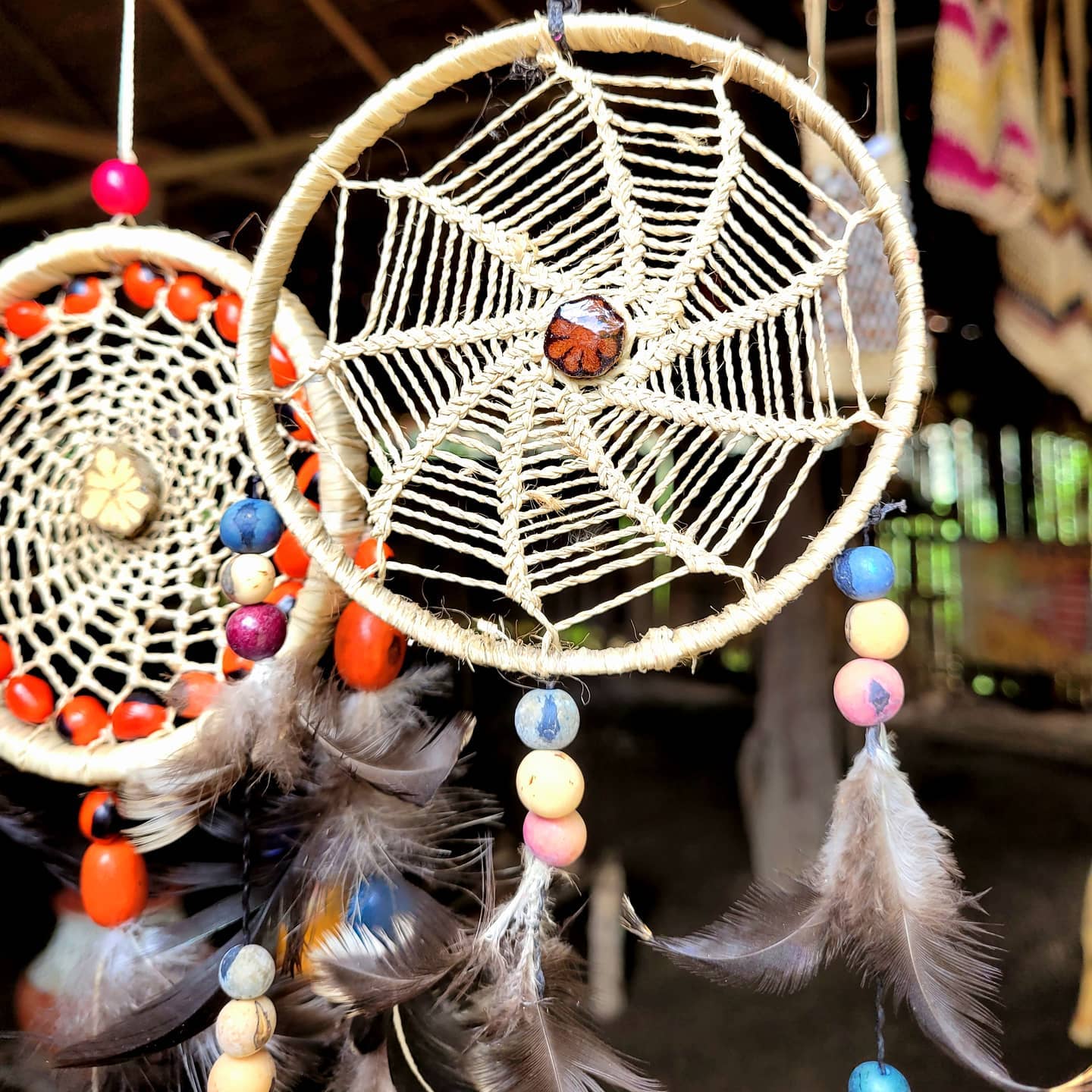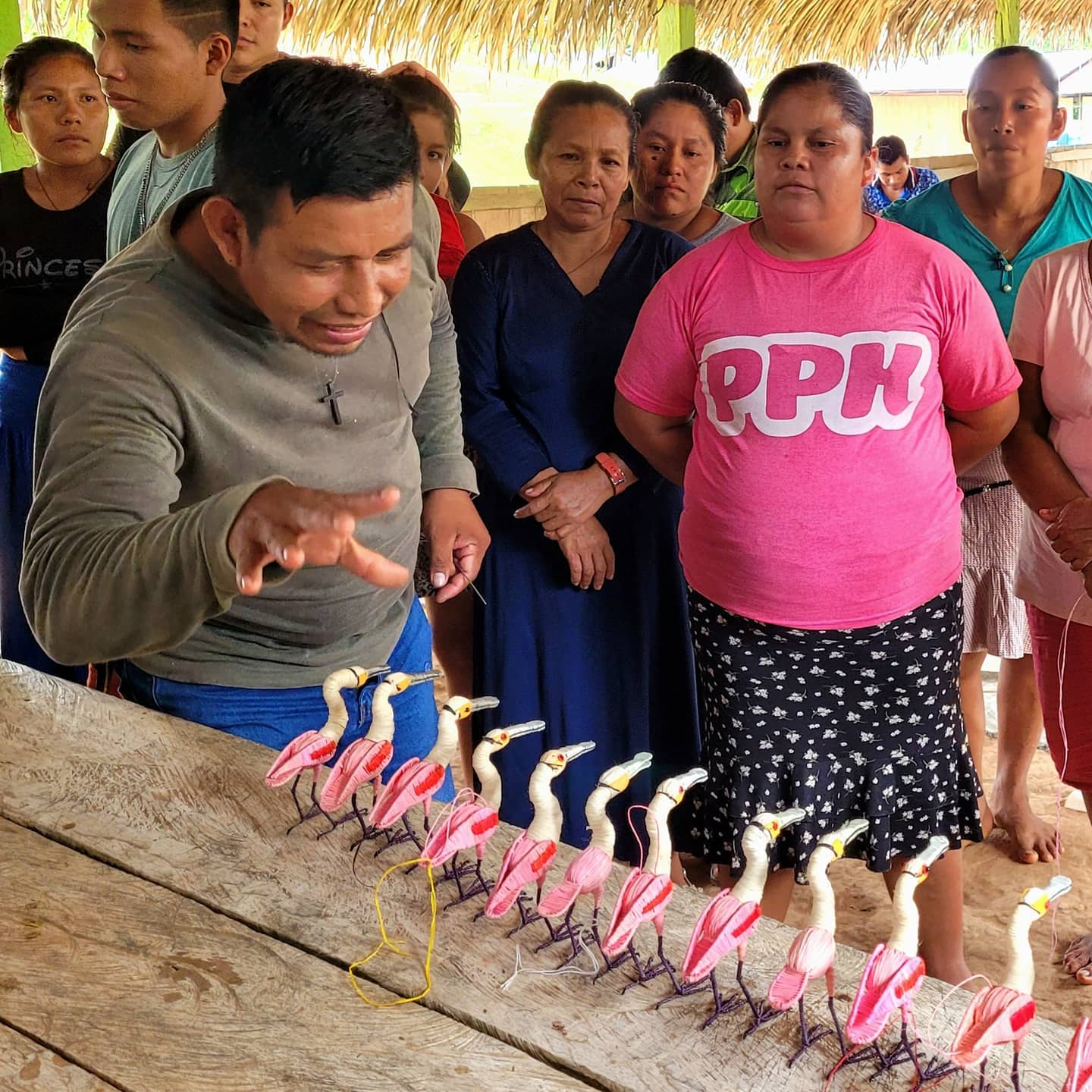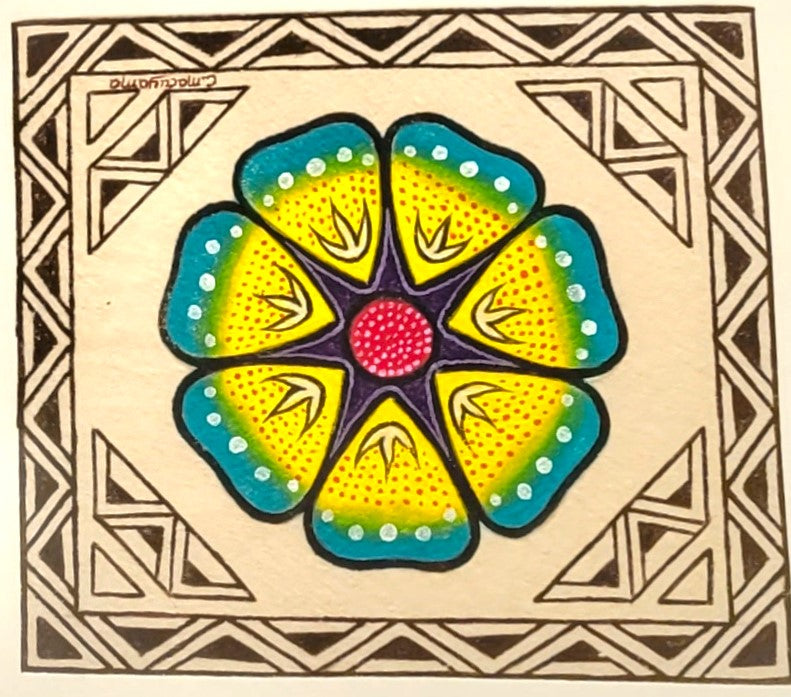Story and photos by Campbell Plowden, Executive Director, Amazon Ecology
I’ve seen Dream Catchers in souvenir shops for tourists around Iquitos for some years, but I had not thought much about buying them as a product for Amazon Ecology to sell because they were actually created by native people (Ijibwe) from North America.
I think it’s fair to debate whether the popularization of these crafts about 50 years ago represents cultural appropriation or adaptation, but when I learned that many of the dream catchers offered for sale in the Iquitos shops were made by native artisans from the nearby community of Padre Cocha, I felt that it was fair to explore whether we could directly support these artisans by buying and selling quality dream catchers made with chambira palm fiber and other local Amazon materials.
After returning from our workshop in San Francisco, Tulio and I headed off one morning on his motorcycle to the Bellavista Nanay neighborhood of Iquitos. We parked his bike and hopped on one of the many small (20 to 30 passenger) boats that carry local people and some tourists to Padre Cocha and other villages on the Nanay River.
En route we passed the 164-foot long Zafiro river vessel owned by Jungle Experiences. While I would love to be able to offer our top-quality crafts to their high-end clients, I don’t think I will be a paying passenger since it costs up to $10,000 per person for a week-long cruise to the Pacaya Samiria national park. After passing under a modern bridge that doesn’t go anywhere (yet?), we reached Padre Cocha in about half an hour on our more modest craft (fare $5).

We asked a motorcar driver to take us to the place where local artisans made dream catchers. We figured he would know since he had one hanging from the back of his cab. His response stumped us a bit because he asked us “which one? There are four Kukama and three Bora malocas (communal buildings) in the area that sell crafts.” Since they were closer, we decided to visit a Kukama maloca first since they were closer and were walking distance from each other.
Tulio and I first arrived at maloca #3 of the Kukama artisan group in Padre Cocha. It had about 16 stalls with some crafts on a table and dream catchers hanging from a beam. The designs and prices seemed similar to Iquitos shops.
My optimism about finding a good source for Amazon dream catchers improved when we met the association president Loidy. She said tbey could make the crafts with specific designs and materials with wholesale pricing. While the macaw and parrot feathers dangling below some models were beautiful, we explained we could not buy any products with wild bird feathers due to conservation concerns and US import restrictions. It was good to learn the domestic “gallina colorado” (colored chicken) could provide an attractive and legal alternative.
We next met the apo (traditional leader) of the maloca who makes baskets and lampshades with strips of cane. While bihao leaves are used to wrap “juanes” (pyramid-shaped rice balls) and cook fish in a “patarashca,” he used a knife to scrape the green outer layer of a stem to reveal its blond core and then split it into narrow strips. The fruit of the ungarahui palm (related to the well known açaí palm) produces tasty ice cream and oil, but its stems yield a versatile material called “cinamillo.” One side looks dark walnut brown, the other has a shiny chestnut brown color.
He then showed us how he uses his hands and foot to interlace these pieces to make a two or three-tone woven craft. It was great to hear he has extensive experience making and sending large orders to other countries. The cylindrical lampshades could be collapsed for compact shipping. We were even more impressed to see photos of a few elaborate custom models.

It was great to make this connection since Yully's and my attempts to work with a skilled cane weaver from Pebas had not worked out because he was hard to find at home or find home sober.
Tulio and I wanted to see what else was available at the other malocas, and Loidy was kind enough to agree to escort us to visit them.
Tulio and I moved on to Kukama maloca #4 where I bought a few dream catchers, necklaces, and wooden rings. I was surprised to see two boys managing one stall. The paintings of Kukama geometric designs, ayahuasca flowers, and butterflies on llanchama tree bark canvas were special.
I bought a few small paintings without Iquitos written across the top. Many tourists like souvenirs labeled with a location, but I assume that crafts without this would appeal to people who haven’t been there.
Our visit to Maloca #1 lasted less than one minute since only one stall was staffed. I would have liked to have bought something from its lone teenage girl vendor, but there wasn’t a single roughly made craft on the cloth tablecloth I thought I could sell. I truly feel bad that so many artisans in the region probably earn very little to support their family because they sell the same simple crafts made by many others. Some tourists do buy these crafts, but many do so more to help the artisan than because they value the quality of their work. One jungle cruise guide told me he had seen his clients put crafts purchased at similar village directly into the trash after returning to their boat.
I fully understand wanting to help poor artisans who can seem desperate to make a sale. I now buy very few crafts that might be called “pity purchases” since I have too many crafts in stock that are hard to sell. I also think such purchases may not help these artisans improve their lives in the long run if they reinforce their sense that their poverty is a stronger selling point than their craftsmanship. Many artisans, however, clearly want to improve the originality and quality of their crafts and readily welcome help to do so.

Amazon Ecology works hard to help some 600 artisans in 18 communities, but this process takes a lot of time and money. Other groups also support artisan training, but there are probably still thousands of artisans in a hundred or more communities who could do better.
Our guide Loidy next led Tulio ad me to our fourth and final Kukama maloca.
After seeing no more than a handful of artisans hanging around the first three malocas in their normal clothes, I was surprised to find the last one full of women adorned in pretty white dresses with Kukama patterns. I assumed they were greeting a specific group of tourists, but I was impressed to learn they showed up at their maloca like this every day to welcome any visitors who stopped by.
The diversity of crafts was only a bit higher than the other malocas, but the place was buzzing with energy. I made a point of visiting every stall making mental notes of pieces I liked. All of the vendors were female, but I was struck how many were girls in their early teens or younger.
Each time I approached a new stall, the girl began a rapid recitation of the crafts: “this is a necklace made with ayahuasca, this bracelet is made with huayruru seeds, this dream catcher is made with chambira.” I thought they might get better results with average tourists if they slowed down their auto-pitches a bit, but I appreciated they had gained enough confidence to try and interact with potential buyers. Many artisans we work with in remote communities are still painfully shy in these circumstances.

The paintings again stood out to me as the most special crafts in this maloca. I bought several more llanchama pieces with flowers and two featuring the kambo frog whose skin exudate is collected to use in a traditional (if somewhat harsh to some) healing ceremony.

After finishing my purchases, I asked to have a photo with the whole group. They clearly had a lot of experience with this ritual and handed me a long decorative staff to hold. I felt a bit awkward thrust into the role of a typical tourist, but I had to accept that I wasn’t special in this environment since I was just another craft buyer to them without an established relationship. They had sincerely appreciated our visit, though, since tourist visits were still infrequent, and I had bought far more than the average visitor.





